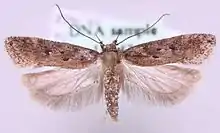Chionodes distinctella
Chionodes distinctella, the eastern groundling, is a moth of the family Gelechiidae. It is found in almost all of Europe (except Croatia),[1] as well as most of Russia, Kazakhstan,[2] Central Asia and North Africa.[3] The habitat consists of dry, rocky heath and meadows and the verges and rough pastures.
| Chionodes distinctella | |
|---|---|
 | |
| Scientific classification | |
| Kingdom: | |
| Phylum: | |
| Class: | |
| Order: | |
| Family: | |
| Genus: | |
| Species: | C. distinctella |
| Binomial name | |
| Chionodes distinctella (Zeller, 1839) | |
| Synonyms | |
| |
The wingspan is 15–19 mm.The terminal joint of palpi is as long as second. Forewings are brown, usually mixed with dark fuscous ; usually indistinct dark fuscous spots on costa near base, at 1/4, and beyond middle, and in disc near base and at 1/4 ; stigmata black, often partly edged with whitish, first discal beyond plical ; an indistinct pale ferruginous-tinged angulated fascia at 3/4, sometimes almost obsolete. Hindwings over 1, light grey.[4]
Adults have been recorded on wing from early June to October in two generations per year in western Europe.[5]
The larvae feed within the roots[6] of Genista and Thymus species, as well as Artemisia campestris.[7]
References
- Fauna Europaea
- "Gelechiidae collection of Siberian Zoological Museum". Archived from the original on 2015-06-10. Retrieved 2013-09-12.
- Junnilainen, J. et al. 2010: The gelechiid fauna of the southern Ural Mountains, part II: list of recorded species with taxonomic notes (Lepidoptera: Gelechiidae). Zootaxa, 2367: 1–68. Preview
- Meyrick, E., 1895 A Handbook of British Lepidoptera MacMillan, London pdf
 This article incorporates text from this source, which is in the public domain. Keys and description
This article incorporates text from this source, which is in the public domain. Keys and description - "LOT Moths and Butterflies". Archived from the original on 2013-08-26. Retrieved 2013-09-12.
- Hants Moths
- "microlepidoptera.nl". Archived from the original on 2014-07-01. Retrieved 2013-09-12.
| Wikispecies has information related to Chionodes distinctella. |
| Wikimedia Commons has media related to Chionodes distinctella. |